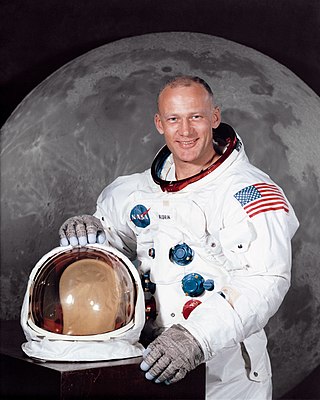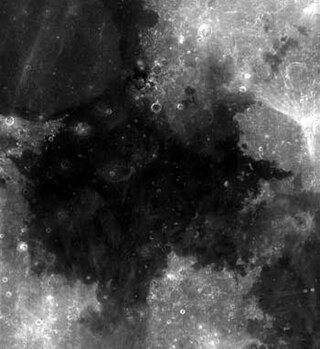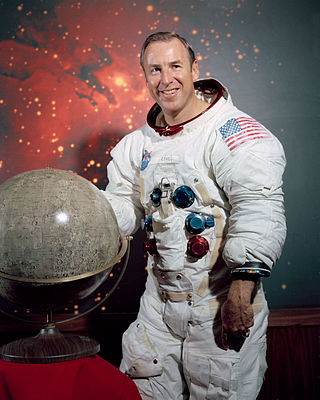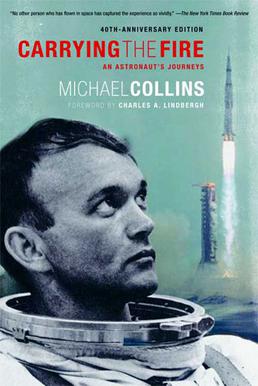Related Research Articles

Apollo 11 was the American spaceflight that first landed humans on the Moon. Commander Neil Armstrong and Lunar Module Pilot Buzz Aldrin landed the Apollo Lunar Module Eagle on July 20, 1969, at 20:17 UTC, and Armstrong became the first person to step onto the Moon's surface six hours and 39 minutes later, on July 21 at 02:56 UTC. Aldrin joined him 19 minutes later, and they spent about two and a quarter hours together exploring the site they had named Tranquility Base upon landing. Armstrong and Aldrin collected 47.5 pounds (21.5 kg) of lunar material to bring back to Earth as pilot Michael Collins flew the Command Module Columbia in lunar orbit, and were on the Moon's surface for 21 hours, 36 minutes before lifting off to rejoin Columbia.

Neil Alden Armstrong was an American astronaut and aeronautical engineer who in 1969 became the first person to walk on the Moon. He was also a naval aviator, test pilot, and university professor.

Buzz Aldrin is an American former astronaut, engineer and fighter pilot. He made three spacewalks as pilot of the 1966 Gemini 12 mission. He was the Lunar Module Eagle pilot on the 1969 Apollo 11 mission and became the second person to walk on the Moon after mission commander Neil Armstrong.

Michael Collins was an American astronaut who flew the Apollo 11 command module Columbia around the Moon in 1969 while his crewmates, Neil Armstrong and Buzz Aldrin, made the first crewed landing on the surface. He was also a test pilot and major general in the U.S. Air Force Reserve.

Mare Tranquillitatis is a lunar mare that sits within the Tranquillitatis basin on the Moon. It is the first location on another celestial body to be visited by humans.

Eugene Andrew Cernan was an American astronaut, naval aviator, electrical engineer, aeronautical engineer, and fighter pilot. During the Apollo 17 mission, Cernan became the 11th human being to walk on the Moon. As he re-entered the Apollo Lunar Module after Harrison Schmitt on their third and final lunar excursion, he remains the most recent person to walk on the Moon.

James Arthur Lovell Jr. is an American retired astronaut, naval aviator, test pilot and mechanical engineer. In 1968, as command module pilot of Apollo 8, he became, with Frank Borman and William Anders, one of the first three astronauts to fly to and orbit the Moon. He then commanded the Apollo 13 lunar mission in 1970 which, after a critical failure en route, looped round the Moon and returned safely to Earth.

Tranquility Base is the site on the Moon where, in July 1969, humans landed and walked on a celestial body other than Earth for the first time. On July 20, 1969, Apollo 11 crewmembers Neil Armstrong and Buzz Aldrin landed their Apollo Lunar Module Eagle at approximately 20:17:40 UTC. Armstrong exited the spacecraft six hours and 39 minutes after touchdown, followed 19 minutes later by Aldrin. The astronauts spent two hours and 31 minutes examining and photographing the lunar surface, setting up several scientific experiment packages, and collecting 47.5 pounds (21.5 kg) of dirt and rock samples for return to Earth. They lifted off the surface on July 21 at 17:54 UTC.

Magnificent Desolation: Walking on the Moon 3D is a 2005 IMAX 3D documentary film about the first humans on the Moon, the twelve astronauts in the Apollo program.

Apollo 11 was the first human spaceflight to land on the Moon. The 1969 mission's wide effect on popular culture has resulted in numerous portrayals of Apollo 11 and its crew, Neil Armstrong, Buzz Aldrin, and Michael Collins.

In the Shadow of the Moon is a 2007 British documentary film about the United States' crewed missions to the Moon. After premiering at the 2007 Sundance Film Festival, where it won the World Cinema Audience Award, it was given a limited release in the United States on 7 September 2007, and in Canada on 19 October.

First Man: The Life of Neil A. Armstrong is the authorised biography of Neil Armstrong, the astronaut who became the first human to walk on the Moon, on July 20, 1969. The book was written by James R. Hansen and was first published in 2005 by Simon & Schuster. The book describes Armstrong's involvement in the United States space program, and details his personal life and upbringing.

Carrying the Fire: An Astronaut's Journeys is the autobiography of the Gemini 10 and Apollo 11 astronaut Michael Collins. It was released in 1974 with a foreword by the aviator Charles Lindbergh. The book was re-released in 2009 to coincide with the 40th anniversary of the first crewed lunar landing, and again for its 50th anniversary, in 2019.
William Carpentier is a Canadian-American physician best known as the flight surgeon assigned to the United States' Apollo 11 mission, the first manned spacecraft to land on the Moon. Carpentier says that this was the highlight of his career. In the months following the Apollo 11 mission, Carpentier became known as a world famous physician. He later went into nuclear medicine research.

Apollo 11 was the first human spaceflight to land on the Moon. In the decades after its 1969 mission took place, widespread celebrations have been held to celebrate its anniversaries.

Apollo 11 is a 2019 American documentary film edited, produced and directed by Todd Douglas Miller. It focuses on the 1969 Apollo 11 mission, the first spaceflight from which men walked on the Moon. The film consists solely of archival footage, including 70 mm film previously unreleased to the public, and does not feature narration, interviews or modern recreations. The Saturn V rocket, Apollo crew consisting of Buzz Aldrin, Neil Armstrong, and Michael Collins, and Apollo program Earth-based mission operations engineers are prominently featured in the film.

Command module Columbia (CM-107) is the spacecraft that served as the command module during Apollo 11, which was the first mission to land humans on the Moon. Columbia is the only spacecraft of the 1969 Apollo 11 mission that returned to Earth.

Lunar Module Eagle (LM-5) is the spacecraft that served as the crewed lunar lander of Apollo 11, which was the first mission to land humans on the Moon. It was named after the bald eagle, which was featured prominently on the mission insignia. It flew from Earth to lunar orbit on the command module Columbia, and then was flown to the Moon on July 20, 1969, by astronaut Neil Armstrong with navigational assistance from Buzz Aldrin. Eagle's landing created Tranquility Base, named by Armstrong and Aldrin and first announced upon the module's touchdown.
References
- 1 2 3 4 5 6 "The Eagle lands again on the moon". The Times and Democrat. Orangeburg, South Carolina. November 17, 1996. p. 33 – via Newspapers.com.
- 1 2 3 King, Susan (November 17, 1996). "Moon Over 'Apollo 11'". The Los Angeles Times. p. 433 – via Newspapers.com.
- 1 2 Jones Jr, Ewart (November 15, 1996). "The Family Channel revisits history in "Apollo 11"". Daily World. Opelousas, Louisiana. p. 23 – via Newspapers.com.
- 1 2 Bobbin, Jay (November 17, 1996). "'Apollo 11' flies on Fam". The Palm Beach Post. West Palm Beach, Florida. p. 221 – via Newspapers.com.
- 1 2 Bobbin, Jay (November 17, 1996). "Movie re-creates flight of Apollo 11". The Atlanta Constitution. Atlanta, Georgia. p. 414 – via Newspapers.com.
- 1 2 3 Nicewonger, Kirk (November 16, 1996). "'Apollo 11' explores human side of historic space launch". News Record. North Hills, Pennsylvania. p. 18 – via Newspapers.com.
- ↑ Richmond, Ray (July 25, 1995). "HBO bests Big 3 in Emmy noms". Variety. Retrieved May 1, 2018.